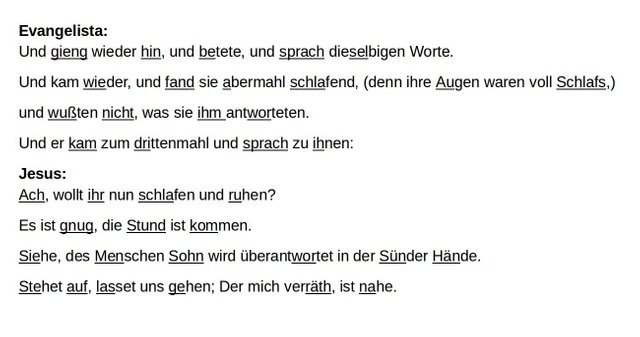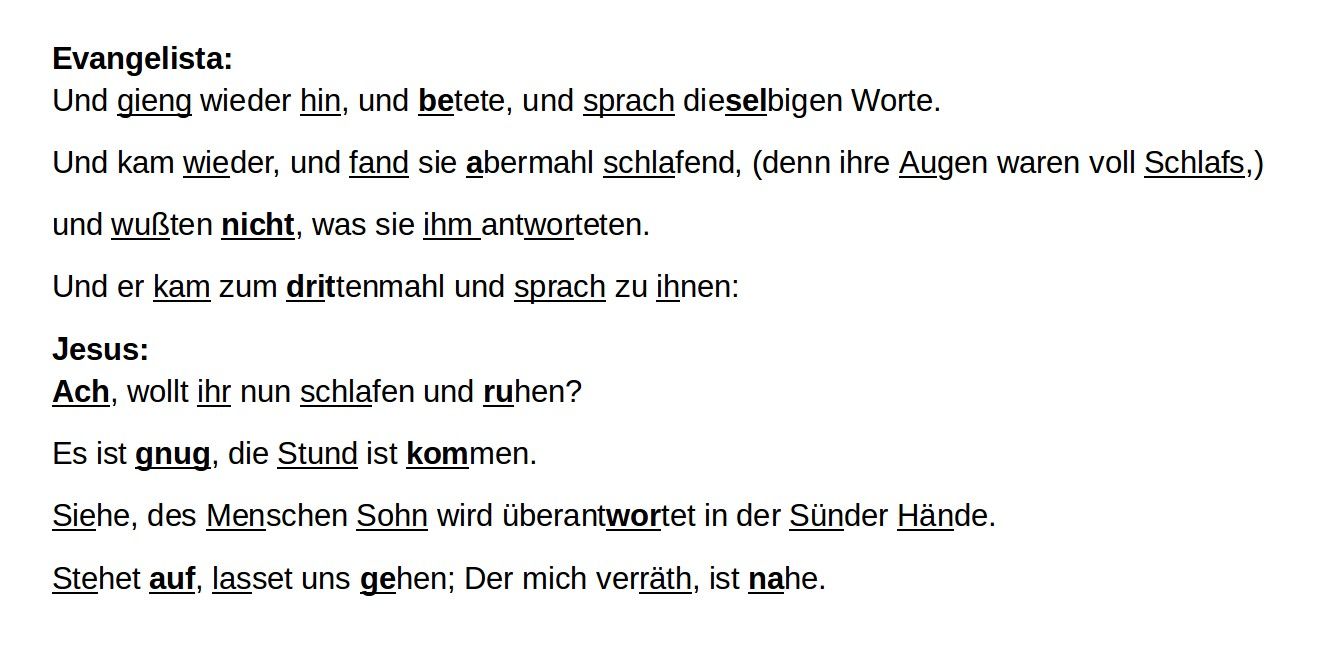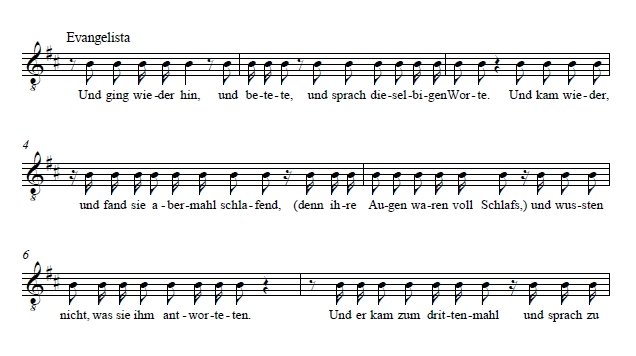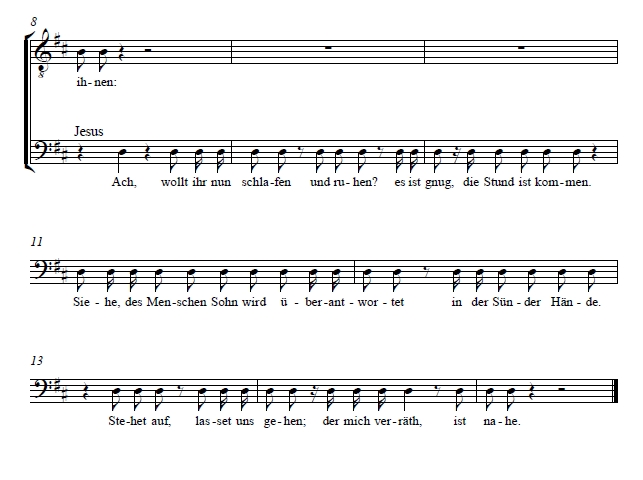The St Mark Passion—A completion of Bach's lost Passion setting (III)
Composing a recitative—An explanation of the procedure using an example from the St Mark Passion
Part 1
This is an appendix to my articles about the completion of Bach's Mark Passion, Part 1 and Part 2. By means of an example, I explain the process of recitative composition.
Before beginning composing the missing parts of the St Mark Passion, I needed to refresh my knowledge about the particular theory of recitative composition. In recitative composition, there is, among other things, a special kind of harmony treatment. In addition, there are certain rules how to handle the distribution of the various syllables within the C-bar or respectively the ⁴/₄-bar. These are especially important in connection with the irregular prose text from the Gospel of Mark, which I had to fit into the regular bar system with its uniform arrangement of accented and unstressed syllables.
For lack of references to this topic by Bach himself (except for his own recitative compositions in his cantatas, of course), I studied every German source on that topic I could get hold of. The most important writings are Johann Mattheson’s Vollkommener Capellmeister (1739), Gottfried Heinrich Stölzel’s Abhandlung vom Recitativ (Treatise on the Recitative, manuscript from around 1739), Johann Adolf Scheibe’s contribution to Bibliothek der schönen Wissenschaften und freien Künste XI–XII, (1764–1765) with the same title and Friedrich Wilhelm Marpurg’s Kritische Briefe über die Tonkunst (Critical letters on music) on recitative composition from 1763.
Most of the existing relevant sources in German date from shortly after Bach’s death. Although remarks on performance and taste (may) differ from Bach’s very own treatment of certain features of recitative composition, the theoretical foundation of recitative composition, the principal treatment of individual syllables, harmony and punctuation marks, has not changed during the 18th century.
It is remarkable by the way, that composers went to the trouble of fitting prose into the bar, although the singers were expected to ignore bar and measurement and declaim (not sing!) the text freely according to its natural pronunciation. However, the notation could anyway be no more than a sketch for the performance.
Although all the eighth notes look the same they all have to have their proper hence different lenhgths, depending on the treatment of the corresponding syllable in natural speech. (I will immerse myself into that later.)
In the following I would like to demonstrate on the basis of the second half of one of my recitatives how I proceeded. Here the text of the complete recitative:

The composition process
During the composition process, I proceeded like a composer from the 18th century. The first step was to analyze the text and examine it for syllable numbers, accents and emphases.
1. Preparation of the text
First I decide which of the stressed syllables have to preferably fall on a stressed beat in the bar:

Adding the emphases (syllables in bold):

2. Text and bar
That followed, I need to fit the text into the C-bar. Here it has to be observed that:
1.) if possible stressed syllables fall on stressed beats in the bar (i.e. 1st and 3rd beat which both are equally important in recitative composition) or at least on a stressed part of any beat
2.) the stressed syllable of a word before a punctuation mark has to fall on either 1st and 3rd beat of the bar


NB: The comma between “Und kam wieder” and “und fand sie...” (bar 3) is an imperfect comma while the comma after that (bar 4, 3rd beat) is perfect. Therefore I chose to let the stressed syllable of the word “wieder” (feminine ending before the first comma) fall on the 4th beat of bar 3 so that the stressed syllable of the word “schlafend” can fall on the 3rd beat of bar 4.
The desperate exclamation of Jesus (Ach!) asks for a particular emphasis, which I achieve by placing it on the 2nd beat as an anticipation of the third beat and adding a rest (also called “suspir” in Bach’s time) after it. The result is a musical rhetorical figure called suspiratio (or Seufzer motif).
In bar 12, I decided to let the word “Hände” fall on the 4th beat because I wanted to avoid a too full 1st half of that bar and a somewhat ‘long’ distance to the next important punctuation mark, the perfect comma after “Steh auf”. Like that all the remaining stressed syllables automatically fall as they should.
to be continued...
Jörn Boysen, March 2018
Running an ensemble is a rewarding but time consuming job. Chasing after grants and sponsorship is the often overlooked but important aspect of a musician's life. If our post has passed the reward period, please consider a donation or a delegation. We also accept tokens of support at the following addresses:
BTC
1Mwe6XaDcREa7o5RSLGoWfk9wSwGs6LkSA
LTC
LPcEtTsxMJykDeK713jsj3e2BsdVf32ix7
ETH
0x1bb1d830f66bdb74de45685a851c42b790587a52
Doge
DMJNS7jbNCgPdFdxgeFdEummFMmSQvAoK2
Musicoin
0x9c1fc741f0869115f8c683dc6967131ab1c40ebc
Smartcash tips accepted!

Our Musicoin artist page
Thanks for you support!

The classical music community at #classical-music and Discord.
Follow our community accounts @classical-music and @classical-radio.
Follow our curation trail (classical-radio) at SteemAuto
Community Logo by ivan.atman

.png)
Thanks for another in depth and information rich article! Resteemed and it will appear in the next curation (with SBD share).
Your post has been supported and upvoted from the Classical Music community on Steemit as it appears to be of interest to our community. You can find details about us below.
The classical music community at #classical-music and Discord.
Follow our community accounts @classical-music and @classical-radio.
Follow our curation trail (classical-radio) at SteemAuto